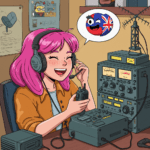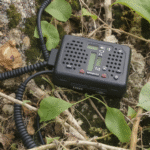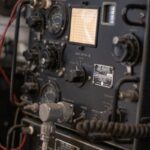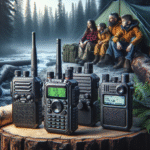Imagine a world where you can connect with people from all corners of the globe, bridging distances and cultures with the power of radio waves. A realm where you can embark on thrilling adventures, communicate in times of crisis, and delve into a rich tapestry of knowledge and exploration. Welcome to the captivating realm of amateur radio – a hobby that promises endless possibilities and boundless excitement.
In this article, we will dive deep into the enchanting world of ham radio communication, providing you with a treasure trove of tips and tricks to ensure your success. Whether you’re an aspiring operator or a seasoned enthusiast looking to enhance your skills, this guide is filled with invaluable insights that will elevate your ham radio experience to new heights.
Why Amateur Radio is an Exciting Adventure
Amateur radio, also known as ham radio, offers a thrilling and captivating adventure for those who dare to explore its depths. It provides a unique opportunity to connect with people from all corners of the globe, transcending boundaries and fostering a sense of global community. Whether you are seeking to expand your knowledge of electronics, communicate during emergencies, or simply enjoy the thrill of making new friends around the world, amateur radio has something truly special to offer.
One of the most exhilarating aspects of amateur radio is its ability to connect people from diverse backgrounds and cultures. Through this hobby, you have the chance to engage in meaningful conversations with individuals you may have never crossed paths with otherwise. Imagine conversing with a skilled engineer from Japan about their latest antenna design or sharing stories about your experiences with a fellow ham operator in Australia. Such encounters foster cross-cultural understanding and create lifelong friendships that span continents.
In addition to its global reach, amateur radio also provides endless possibilities for personal growth and learning. As you embark on this adventure, you will acquire technical skills in electronics, signal propagation, antenna design, and more. You will gain an intimate understanding of how radio waves travel through space and interact with different terrains or atmospheric conditions.
These skills not only enhance your ability to communicate effectively but also empower you in other areas of life. With each successful contact made on your ham radio station, you gain confidence in your abilities as an operator while expanding your knowledge base.
Connecting with a Global Community
Ham radio, also known as amateur radio, is more than just a hobby. It opens up a world of possibilities for connecting with fellow enthusiasts from all corners of the globe. The beauty of ham radio lies in its ability to transcend borders, cultures, and languages, allowing individuals to form meaningful connections with people they may never have met otherwise.
Imagine sitting in your cozy radio shack late at night, tuning into a frequency and suddenly hearing a distant voice crackling through your speakers. It could be someone from the other side of the world—a fellow ham operator eager to make contact and exchange stories. The feeling of excitement and anticipation in those moments is indescribable. It’s like discovering a hidden treasure chest filled with fascinating tales waiting to be shared.
Through ham radio, you become part of an extraordinary global community united by the love for communication and exploration. You can engage in conversations about diverse topics such as technology advancements, weather conditions, cultural practices, or simply exchanging pleasantries and well wishes. This interconnectedness fosters understanding between individuals from different backgrounds while offering an opportunity for personal growth and expanding one’s horizons.
The Journey Begins: Getting Your License
Embarking on the thrilling adventure of amateur radio communication begins with obtaining a license. This crucial step not only grants you legal access to operate your radio equipment but also ensures that you possess the necessary knowledge and skills to navigate this fascinating world. Acquiring a ham radio license is relatively straightforward, and it opens up a realm of possibilities for connecting with people from across the globe.
To obtain your ham radio license, you must pass an examination administered by your country’s regulatory authority. The exam typically assesses your understanding of fundamental concepts such as radio wave propagation, electrical theory, operating procedures, and regulations specific to amateur radio. Fear not! With ample study resources available online, in books, and through local amateur radio clubs, you can confidently tackle the exam.
Studying for the test offers an excellent opportunity to delve into the theoretical aspects of amateur radio while gaining practical knowledge that will enhance your overall experience. As you immerse yourself in learning about wavelengths, circuitry, antennas, modulation techniques, and more, you’ll develop a solid foundation for successful ham radio communication. Embrace this learning process as an exciting journey towards becoming a licensed operator – each page turned or concept grasped brings you closer to unlocking the wide-ranging possibilities that await.
Building Your First Ham Radio Station
Congratulations! You’ve embarked on an exciting journey towards building your very own ham radio station. As you venture into the world of amateur radio, having a well-equipped and properly set up station is vital for clear and effective communication. Let’s dive into the essential components and considerations when constructing your dream radio station.
1. Selecting the Right Transceiver: The transceiver serves as the heart of your ham radio system, allowing you to transmit and receive signals. Consider factors such as power output, frequency coverage, modulation modes, and durability when choosing a transceiver that suits your needs. With a vast array of options available, take your time to research and seek recommendations from experienced hams to find the perfect fit.
2. Power Supplies: Reliable power is key for uninterrupted communication. While some hams choose batteries or generators for portable setups, a stable AC power supply is crucial for a home-based station. Invest in a high-quality power supply unit (PSU) that can handle the demands of your equipment while providing clean power to minimize interference.
3. Antennas: An antenna is like an artist’s brushstroke on the canvas of the airwaves, determining how far and clearly your signals will reach. From dipole antennas to directional yagis or wire antennas for limited spaces – there are numerous types to choose from based on factors like available space, desired frequencies, and signal directionality. Remember to consider height above ground level too; elevation can significantly enhance signal propagation.
Creating your own ham radio station is an exhilarating experience filled with endless possibilities for exploration and connection with fellow enthusiasts worldwide. By carefully selecting a suitable transceiver, ensuring reliable power supplies, and meticulously optimizing antenna configurations – you are well on your way to establishing a station that will bring joy and fulfillment to your ham radio adventures.
The Art of Radio Etiquette: Communicating Effectively
When it comes to ham radio communication, mastering the art of radio etiquette is essential for smooth and effective communication. Whether you are participating in a casual conversation or handling emergency communications, following proper radio etiquette ensures clarity, respect, and an enjoyable experience for all involved.
First and foremost, it is crucial to listen before you transmit. This simple yet often overlooked rule allows you to understand the ongoing conversation and avoid interrupting others. By patiently listening, you gain valuable insights into the flow of communication and can time your transmissions appropriately.
Another key aspect of radio etiquette is using clear and concise language. Avoid unnecessary jargon or slang that might confuse fellow operators. Instead, speak slowly and enunciate each word clearly to ensure that your message reaches its intended audience without any ambiguity. Remember, effective communication is about transmitting information accurately while maintaining a respectful tone.
Exploring Bands and Frequencies: A World of Possibilities
When it comes to ham radio communication, the world is your oyster. The vast array of bands and frequencies available to amateur radio operators offers an exciting playground for exploration. Each band has its unique characteristics and propagation properties, allowing for a diverse range of experiences. Whether you’re a seasoned ham or just starting out, understanding these bands and frequencies is crucial for unlocking the full potential of your radio adventures.
The HF (High Frequency) bands, ranging from 1.8 MHz to 30 MHz, are often considered the heart and soul of amateur radio. These bands allow for long-distance communication, bouncing signals off the Earth’s ionosphere to reach distant locations around the globe. They provide an opportunity to connect with fellow hams in far-flung corners of the world, fostering a sense of global community that knows no boundaries.
For those seeking local connections and real-time conversations with neighboring hams, VHF (Very High Frequency) and UHF (Ultra High Frequency) bands offer optimal options. These bands span from 30 MHz up to several gigahertz, allowing for line-of-sight communication within a limited range. From handheld radios for chatting with friends across town to repeater systems that extend your reach even further, VHF/UHF opens up endless possibilities for local interactions.
Mastering Morse Code: Unlocking an Ancient Skill
Amidst the ever-evolving landscape of modern communication, there lies a time-honored tradition that harks back to the early days of telegraphy – Morse code. The rhythmic series of dots and dashes has captivated the hearts of ham radio enthusiasts for generations. Mastering this ancient skill not only adds a touch of nostalgia to your ham radio experience but also opens up a whole new world of possibilities.
Learning Morse code may appear daunting at first, but with determination and practice, anyone can unravel its mysteries. Begin by familiarizing yourself with the basic alphabet and numbers. Start by memorizing common groupings like SOS (· · · – – –) or CQ (– · – ·). To reinforce your learning, utilize resources such as online tutorials or mobile apps that offer interactive exercises and quizzes.
The key to success in mastering Morse code lies in regular and consistent practice. Create a daily routine where you spend dedicated time honing your listening and decoding skills. Gradually increase the speed at which you receive and transmit messages, challenging yourself to reach higher levels of proficiency. It is through perseverance that you will unlock the ability to communicate effortlessly using this captivating language.
Antennas: The Heart of Your Radio Station
When it comes to successful ham radio communication, a crucial component that often gets overlooked is the antenna. Just like the heart pumps life-giving blood throughout our bodies, the antenna is what allows your radio station to send and receive signals, connecting you with fellow enthusiasts across the airwaves. So, let’s dive into the fascinating world of antennas and discover how they can elevate your ham radio experience.
There is an incredible variety of antennas available to suit different purposes and environments. From dipole antennas that are easy to construct and widely used for general communication, to Yagi-Uda arrays offering directional capabilities for long-distance contacts, each design has its own unique characteristics. The key lies in finding an antenna that best matches your needs and operating conditions.
One intriguing aspect of antennas is their ability to interact with the surrounding environment. Factors such as height above ground, nearby obstructions, and even weather conditions can influence how efficiently an antenna radiates or receives signals. By experimenting with different setups and carefully tuning your antenna system, you can optimize its performance and greatly enhance your communication range.
Weathering the Storm: Emergency Communication Preparedness
In times of crisis, when traditional communication infrastructure may be compromised or unavailable, amateur radio operators play a crucial role in providing reliable emergency communication. Being prepared for such situations is essential for ham radio enthusiasts. Here are some tips and tricks to ensure your emergency communication preparedness:
1. Build a Robust Emergency Communication Kit
An effective emergency communication kit is the backbone of your preparedness plan. Start by assembling a portable ham radio system, including a transceiver, batteries or alternative power sources, and essential cables. A sturdy antenna setup capable of handling various frequencies is also crucial. Additionally, pack spare parts, tools, maps, and a comprehensive first aid kit.
Consider including other items such as weatherproof notebooks and pens for recording critical information, a flashlight with extra batteries or a hand-cranked version for prolonged use during power outages, and solar chargers to keep your devices powered up in case of prolonged emergencies.
2. Establish an Emergency Communication Network
No man is an island – this sentiment holds true in emergency situations as well. Establishing connections with fellow ham radio operators in your area is vital for effective emergency communication networks.
Collaborate with local amateur radio clubs and organizations to set up regular practice sessions focused on emergency scenarios. This will enable you to gain experience in handling critical situations while forming bonds with other operators who can support each other during emergencies.
3. Stay Informed and Practice Regularly
To be successful in providing emergency communication assistance during crises, staying informed about current events and practicing regularly are fundamental.
Maintain updated knowledge about weather patterns that may escalate into emergencies or natural disasters in your area. Familiarize yourself with emergency protocols and any specific regulations related to amateur radio operations during emergencies.
Regularly participate in emergency drills and simulated scenarios to fine-tune your skills in a controlled environment. This will ensure that you are well-prepared and confident when it truly matters, helping you provide significant support to your community during challenging times.
By following these tips and tricks, you will be well-equipped to weather any storm and provide essential communication assistance when it is most needed. Remember, the knowledge and skills you possess as a ham radio operator can make a significant difference in times of crisis, reaffirming the invaluable role of amateur radio in our interconnected world.
Taking Your Ham Radio Adventures to the Great Outdoors
There is an adventurous spirit that comes alive when taking your ham radio activities to the great outdoors. From mountain peaks to serene lakeshores, exploring the world of amateur radio in nature opens up a whole new realm of possibilities and experiences. Whether you are an avid hiker, camper, or simply love being surrounded by nature’s beauty, here are some tips to ensure your outdoor ham radio adventures are successful and unforgettable.
Choosing the Perfect Location
The first step in embarking on your outdoor ham radio adventure is finding the perfect location. Look for places that offer a clear line of sight with minimal obstructions such as tall trees or buildings. Consider setting up your station on higher ground to maximize signal propagation. National parks, campgrounds, and remote hiking trails often provide opportunities for both natural beauty and optimal radio transmission.
Remember that safety should always be a top priority when selecting your spot. Ensure you have access to emergency services if needed and be aware of any potential weather hazards or wildlife encounters. With careful planning and preparation, you can find that ideal setting where nature’s splendor blends harmoniously with your love for amateur radio.
Gearing Up for Outdoor Operation
When venturing into the outdoors with your ham radio equipment, it is crucial to pack efficiently and thoughtfully. Consider lightweight camping gear options to minimize the load without compromising on essential items. Invest in durable backpacks or cases specifically designed for carrying sensitive electronic equipment.
In addition to packing essentials like food, water, and appropriate clothing, make sure you have all necessary radio equipment such as portable antennas, spare batteries, coaxial cables, and tools for assembly/disassembly. It’s also wise to include a weatherproof cover for protection against unexpected rain showers or other challenging weather conditions.
Exploring Nature and Making Connections
Once you are set up in your chosen outdoor location, it’s time to immerse yourself in the wonders of both amateur radio and nature. Take a moment to appreciate the breathtaking scenery around you, allowing it to inspire your communication experiences. Whether you are making contacts with fellow hams in distant locations or participating in contests, let the beauty of nature enhance your connection with the global ham radio community.
Take advantage of the potential for portable operations by participating in outdoor events like field days or activating rare locations for ham radio awards. Experiment with different antennas and propagation techniques to optimize signal strength and range. Embrace the freedom that outdoor ham radio offers, where every transmission becomes an opportunity for exploration and discovery.
As you conclude your time spent outdoors indulging in ham radio activities, take a moment to reflect on how this unique combination of technology and nature has enriched your experience. The memories made, connections formed, and skills honed throughout your outdoor adventures will undoubtedly leave an enduring imprint on both your passion for amateur radio and your love for the great outdoors.
Preppers & Ham Radio
When it comes to emergency preparedness, ham radio enthusiasts, often referred to as “preppers,” have found a valuable ally in their hobby. Ham radio provides a reliable means of communication during times of crisis when traditional communication channels may be compromised or offline. With their ability to operate independently of power grids and internet infrastructure, ham radios become an essential tool for preppers looking to stay connected and informed in times of need.
One of the primary advantages of ham radio for preppers is its long-range capabilities. Unlike other forms of communication that rely on cell towers or satellites, ham radios can reach beyond these limitations by using repeaters and antennas that amplify signals over vast distances. This allows preppers to connect with other like-minded individuals, share information, and gather valuable updates about the situation at hand.
Another aspect that makes ham radio appealing to preppers is its versatility. By obtaining the necessary licenses and equipment, preppers can tap into various frequencies across different bands, enabling them to communicate locally or globally depending on the circumstances. This flexibility ensures that even if local networks are down or overloaded during an emergency, preppers can establish contact with fellow operators nearby or across continents. The sense of community fostered by this global network is not only comforting but also empowers individuals by providing a lifeline when it matters most.
Conclusion
In conclusion, the world of ham radio is a captivating realm that offers countless opportunities for exploration, connection, and personal growth. As you embark on your journey as a licensed amateur radio operator, remember to embrace the camaraderie of the global ham radio community and approach each interaction with kindness and respect. Through mastering the art of effective communication, understanding different bands and frequencies, honing your Morse code skills, optimizing your antenna setup, and being prepared for emergencies, you will find yourself equipped with the tools to enjoy successful ham radio adventures. So go forth and let your voice be heard across the airwaves – may it resonate with curiosity, friendship, and a passion for lifelong learning.





